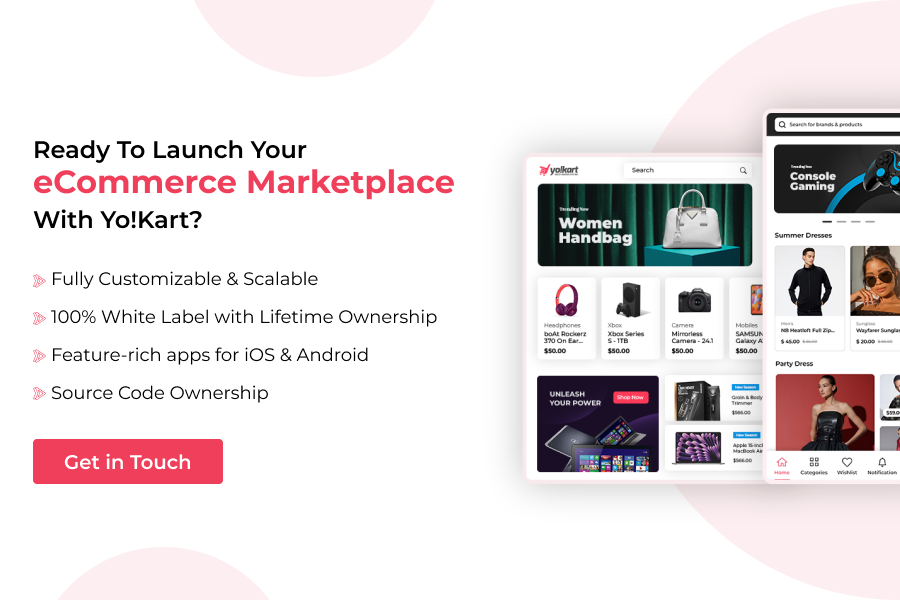Jewelry is as timeless as the pyramids of Egypt, often symbolizing beauty, sentiments, and wealth. Over time the designs might have changed, but the emotions and charm of something like a wedding ring are enduring, transcending generations. This ceaseless demand continues to spur business in the industry – involving crafters, designers, investors, traders, and businesses involved in the value chain.
According to Statista, the worldwide online jewelry market is predicted to reach a value of $117 billion in 2027. These are promising numbers, indicating an opportunity in the industry to conduct jewelry business via online channels. In this blog, read valuable insights on how to start an online jewelry business and enter this thriving and continuously growing industry.
Table Of Contents
Top Business Ideas to Start Jewelry Business Online
Given the involvement of multiple skilled professionals, businesses, and specialists ― online jewelry businesses can work in any of the multiple niches and business models to connect buyers with their needs. Let’s see how this can be done.
Fine Jewelry
Catering to the luxury end of the market with high-ticket products, fine jewelry includes rare gemstones, precious metals, and unique designs – crafted with extensive attention to detail. Buyers may also buy fine jewelry for long-term investment, as some pieces increase in value over time attracting high resale prices. Wedding bands, engagement rings, and gemstone earrings are some examples of fine jewelry.
Fine Jewelry Popular Player: Boylerpf
Currently, fine jewelry is majorly sold as a product category on luxury eCommerce marketplaces like Nordstrom, via multi-retail omnichannel businesses like Mejuri, or eCommerce marketplaces like Boylerpf.
Fashion Jewelry
More accessible and affordable, fashion jewelry is more dynamic and caters to the latest trends and styles. It involves the use of affordable raw materials like faux gemstones and electro-plated metal. It also incorporates more economical development processes. However, fast fashion trends may mean styles can go out of style faster, so the marketplace business model is ideally suited to this jewelry niche.
Fashion Jewelry Popular Player: Jedora
Jedora is a dedicated eCommerce marketplace for jewelry, watches, and gemstones. It connects popular and upcoming brands, designers, and best-in-class manufacturers, with the buyers.
Vintage or Antique
Going by just the meaning of these words, vintage refers to jewelry dating from more than fifty years to less than a century old items, while antique is more than a century old jewelry. To add a reference to the design of the item, the eras throughout history are divided as Georgian (1715 – 1830), Victorian (1830 – 1900), Art Nouveau (1890 – 1920), Edwardian (1900-1920), Art Deco (1920 – 1935), Retro (1935 – 1960), Mid-Century Modern (1960-1975). Jewelry under these categories includes both items that are pre-owned possessions from that period and reproductions/replicas of these items.
Vintage and Antique Jewelry popular players: Eragem, Antique Jewelry Mall.
While Eragem sells authentic pre-owned vintage/antique jewelry, Antique Jewelry Mall sells both authentic and replicas.
P2P Jewelry Resale/Trade
How can a Jewelry eCommerce business offer sustainable, cost-efficient products, without needing to own any inventory? The answer is a P2P resale eCommerce platform. On such a platform, users can either register as sellers to sell pre-owned products they don’t wish to own anymore ― or register as buyers to buy these from the sellers. The role of the business is to facilitate these transactions. However, some P2P platforms play a more active role as intermediaries ― by authenticating the products before the buyers purchase them.
Pre-owned jewelry marketplace popular player: WP Diamonds, Louped
WP Diamonds is a P2P jewelry marketplace for the trade of pre-owned products. It offers pre-owned diamonds, fine jewelry, luxury watches, and other designer high-ticket products.
Jewelry Auction Marketplace
While the niche for this marketplace is the same as a jewelry resale platform, the business model varies. On such a platform the sellers can auction their products for the buyers. Such businesses generally cater to expensive products.
Jewelry auction marketplace popular player: Worthy
Worthy is a jewelry auction platform that allows sellers to auction pre-owned items. The buyers are vetted by Worthy to facilitate trust on the platform.
Collectibles eCommerce platform
Closely related to vintage jewelry, a collectible marketplace allows sellers to sell jewelry beyond just wearables. These can include jewelry like timepieces or home decor. Moreover, these can include a wide assortment of jewelry beyond crafted metal and precious stones.
Collectibles popular player: Ruby Lane
This is a marketplace for wide-ranging collectibles. It allows sellers to offer a fixed price for products along with the option of RFQ.
Build a Jewelry marketplace with RFQ functionality
Personalized/Custom-made Jewelry
“Made-to-order,” or personalized jewelry for each buyer, is a niche in itself leveraging custom designs by boutique sellers. While buyers get personalized adornments, custom-processing can be time-consuming, catering to specifically high-ticket sales.
Custom Made Jewelry popular player: Blue Nile
Blue Nile is a jewelry e-retailer, renowned for its extensive and exquisite collection of high-quality diamonds and fine jewelry. It offers an intuitive interface that allows buyers to personalize their chosen items.
Jewelry Dealing
While users can sell jewelry in good condition on auction or resale e-marketplaces, what about broken or unusable jewelry? Such jewelry is sold to wholesalers who give cash in return. Starting with an online jewelry marketplace that connects users with this need, allows businesses to operate in a largely exclusive niche.
Jewelry Dealing popular players: Cash For Gold, Express Gold Cash.
Express Gold Cash gives cash payouts for gold, diamonds, and other jewelry.
B2B Online Jewelry Business
Connecting supply chain participants in B2B trade through digital channels, and aggregating a fragmented industry – often streamlines operations, expedites bottlenecks, brings in additional value, navigates complexities, and adds transparency to processes. The jewelry B2B trade is no different and has global opportunities for smaller or bigger businesses to explore digital sales disruption.
Jewelry B2B marketplace popular player: UNI Diamonds
UNI Diamonds is the world’s first B2B diamond trading platform based out of Israel. The marketplace streamlined B2B diamond trade with a platform that provides transparency in the ecosystem. Traders can evaluate, bid, or buy diamonds in a digital ecosystem that has revolutionized legacy processes with a purpose-built eCommerce platform.
Jewelry from Sustainable Materials.
With rising climate crisis awareness, consumers are being increasingly drawn towards sustainable products. The jewelry industry is no different. Given this trend, eCommerce marketplaces catering to such consumer needs have a good opportunity.
Jewelry B2B marketplace popular player: Brilliantearth
This is a marketplace for jewelry that is ethically sourced with traceable origins.
Upcoming Future Trends in the Jewelry Industry
The business ideas we discussed above are doing well in the industry ― having been adopted by successful eCommerce businesses. However, the jewelry industry is a dynamic ecosystem, especially when facilitated by eCommerce. This means further opportunities. So let’s discuss some opportunities that haven’t been explored upto the limit. At the moment, some of these niches are fragmented. Some have sellers operating on bigger horizontal businesses like Etsy, while some have online stores. So there are opportunities to be explored. Some of these are:
- 3D Printed Jewelry: According to Databridge market research, the market for 3D printed jewelry will be valued at USD 22751.13 million by 2030, growing at a CAGR of 13.50%. This technology enables the production of intricate and complex designs with ease. It offers greater flexibility in design, and the ability to offer a wider range of products at competitive prices.
Example of an eCommerce Business: Shapeways
- Smart & Connected Jewelry: Smart Jewelry adds to the list of Internet of Things (IoT) wearable tech. To add to smartwatches, now more brands are coming up with smart rings. Such wearables can monitor health, track fitness, and even send notifications.
Example of an eCommerce Business: Ultrahuman
Launch your Online Jewelry Business
How to Start a Jewelry Business Online
Something you would have observed in the section above, that there are multiple opportunities for the taking in the jewelry industry. However, to encash on these, you can follow a process that lets you start a jewelry business online.
Step 1: Research
The first thing to starting an online jewelry business is you want to understand the market. Get pivotal data to work with. Some questions that need an answer are:
- Competitive analysis: What do the competitors offer in the market?
- Users’ needs: Are buyers’ needs being met by the existing competition? Is there a group of sellers that have a common pain point that needs to be addressed?
- Business Feasibility: Analyze the demand and supply. Identify a gap in the market.
- Understand the niche: Get data on profitability, availability, and other information related to the niches. For instance, business requirements for offering fine jewelry would be different as opposed to fashion jewelry.
Step 2: Design Your Business Strategy
Decide the role you want to play in the eCommerce marketplace. There are a few alternatives that you can analyze:
- Manage the backend operations only like Etsy, and connect third-party sellers with buyers.
- Play a more active role as an intermediary, such as authentication.
- Offer your inventory alongside third-party sellers.
- Aggregate lesser-known sellers, and keep your brand at the forefront. Here the buyers are under the impression that they are doing business with your brand and not the sellers.
- Offer just services like jewelry design on the jewelry eCommerce platform.
Step 3. Develop your business model
The business model of the jewelry eCommerce platform depends on your chosen idea. Let’s discuss the options:
- B2B2C: Third-party vendors sell to the buyers. eCommerce infrastructure is managed by the entity that owns the eCommerce platform.
- B2B: The only difference between B2B and B2B2C is that the buyers are businesses.
- P2P: Users register as sellers or buyers to trade products.
- C2B: Consumer creates some value for the business, for instance, Cash For Gold jewelry business.
Step 4: Decide on Revenue Streams
In an eCommerce marketplace, your options for primary revenue streams are the following:
- Commissions: Levy a percentage of the sellers’ profits from the jewelry eCommerce platform.
- Subscription: Introduce recurring revenue streams by way of tiered subscription plans. This is done in exchange for services or benefits.
- Monetize Advertisements: Your website banner image, along with targeted ad placements, can generate revenue.
Step 5: Evaluate your needs for the eCommerce platform
Depending upon the chosen business plan and strategies, operative niche, and other factors, the eCommerce platform will need some essential functionalities. Let’s see some pivotal of these for online jewelry marketplaces.
- Engaging and fluid UI/UX to offer buyers a shopping experience they are used to in offline stores.
- Capability to easily publish detailed product descriptions, along with videos and downloadable certification documents.
- Options for the business to promote the best-performing shops and products on the platform.
- Fully automated and integrated shipping solutions within the platform.
- Features like wishlist and abandoned cart, as buyers can take time in reaching a purchase decision.
- Customer care solutions like online chat, a key to building trust for the customer.
- Marketing tools for promotions and sales.
- Connected to social media for sharing and marketing.
- Customer review and rating system to foster trust.
- Customizable, independent storefronts for sellers.
These are some of the essential features for starting an online jewelry business. However, you may need more if you have a very specific business plan.
Step 6: Build your jewelry eCommerce platform
After evaluating your needs, you can proceed with the next step, i.e. building your eCommerce platform. It is recommended that you prefer a turnkey jewelry eCommerce solution for your business. These undercut both the costs and go-to-market time frame for a startup business when you compare it to the traditional eCommerce development approach.
Moreover, your eCommerce journey will unfold, bringing in new considerations for you at each step. Hence, it is important that you prioritize a customizable eCommerce solution that is also holistically supported by a team that you can partner with for the long term.
Step 7: Market your jewelry eCommerce platform
After the platform has been deployed, the next significant endeavor is to put your business in front of the target audience, i.e. market your jewelry eCommerce platform. Let’s discuss a powerful and comprehensive marketing strategy that business owners can leverage for their jewelry marketplaces to help them stand out ― and achieve their business goals.
- Launch Paid Media Advertising Campaigns: Leverage the popularity of social media platforms such as Facebook, Google, and Twitter by publishing paid advertising options. Additionally, prudently chosen high-performing and popular publications and blogs can also leave an impact.
- Collaborate with Influencers: Influencers can be open to partnering with brands to advertise their products. This is one of the better ways to expand your reach.
- Create Content Marketing & SEO Strategy: Content marketing involves publishing marketing collateral in the form of articles, videos, infographics, emails, and more. This strategy is highly effective in today’s media-focused world where people conduct research before making purchases.
- Launch a Newsletter: Build your brand with a consistent user engagement. An email newsletter can be a valuable marketing tool to keep the target audience intrigued by your jewelry brand and the products on offer.
- Leverage User Generated Content (UGC): Jewelry shopping, especially that involves high ticket purchase decisions, hinges on buyer trust. UGC in the form of User Reviews and testimonials play a significant role in building that trust to trigger purchase decisions.
Turnkey eCommerce Solution to Launch Jewelry Business
Wrapping Up
In essence, the online jewelry industry is thriving and presents opportunities for both new and established businesses. A Jewelry marketplace platform can serve as a central hub to attract and build trust with customers. To leverage a distinct USP, the marketplace can be built to cater to a specific sub-niche or cover alternate business opportunities within the jewelry industry.
Success in this industry requires a strategic approach, adaptability to changes, and a focus on branding, industry trends, new products, and marketing strategies. Maintaining strong customer relationships through various channels is also crucial. It is important to balance technology, marketing, and human operations to create a satisfying and engaging customer experience.
To build a jewelry eCommerce platform, Yo!Kart, a leading turnkey solution can provide a convenient, fast, and affordable way to build a contemporary Jewelry platform with essential eCommerce features, pre-integrated business APIs and payment gateways. Additionally, any personalization required can be availed with the in-house Agile team.
FAQs
Q. How much does it cost to build an online jewelry platform?
Ans: To build an online jewelry platform, you have to take into account expenses in the website development,such as planning, designing, developing, and testing the platform. Generally eCommerce development companies charge on a per hour basis. So the total investment can range from hundreds to thousands of dollars, depending on your goals and target market. However, if you opt for a turnkey solution instead, you can undercut these costs significantly, provided you choose wisely.
Q. How can I launch an online jewelry marketplace?
Ans: To launch an online jewelry marketplace consider following these steps:
Step 1: Research: conduct a comprehensive research regarding the audience, product price, demand, existing competition, and availability of suppliers.
Step 2: Design Your Business Strategy: Analyze and decide on your business strategy, how and what type of role you want to play in the business.
Step 3. Develop your business model: Choose between B2B2C, B2B, P2P, and C2B business models.
Step 4: Decide on Revenue Streams: Choose between commissions, subscription packages, and ad monetizing.
Step 5: Build your jewelry eCommerce platform: Choose a capable turnkey solution to build your platform.
Step 6: Market your online jewelry business.
Q. How can I effectively market my online jewelry business?
Ans: To market your online jewelry business, consider following these tips:
– Launch Paid Media Advertising Campaigns.
– Collaborate with Influencers.
– Create Content Marketing & SEO Strategy.
– Launch a Newsletter.
– Leverage User Generated Content (UGC).
Q. How do I choose the right e-commerce software for my jewelry business?
Ans: The right eCommerce software for a jewelry business can have the following virtues:
– Features to allow the sellers to sell and build their brand. Some of these are independent storefront and a product catalog with purpose-built functionalities.
– Similarly, the marketplace operator will need to build a cohesive ecosystem that supports eCommerce operations for all the participants and allows them to churn revenue from the business.
– Moreover, a focused approach that gives buyers a shopping experience they are used to in offline jewelry stores.
– The eCommerce platform needs to be secure and also facilitate transactions reliably.
– Finally, ensure that the eCommerce software is a good long term solution. For this, a marketplace solution that is popular, customizable and has the support of team, will help you navigate through unpredictability and complexities in your eCommerce journey.




